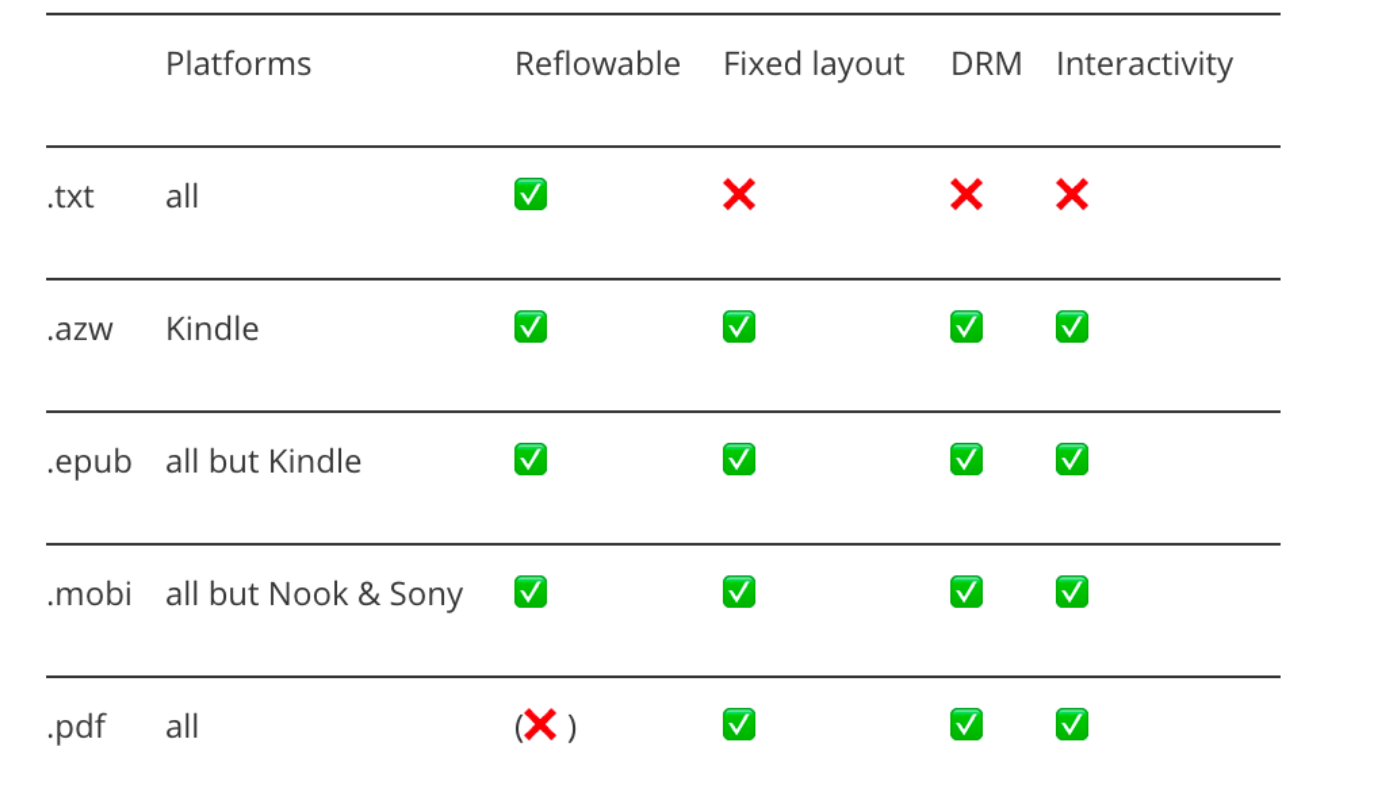

So, you’ve conquered the question of “What is an eBook?” You’ve figured out how to make an eBook, and now, I’m guessing you’re here for a little guidance on completing your eBook, am I right?
Great news, I’m here to give you that guidance.
I’m sure you’ve done your fair share of Google searches at this point and haven’t found your answer. I did the same. In fact, I ended up more confused than when I started. So, to spare you the trouble, I’ll share my findings with you.
There are quite a few options for eBook formats. Dozens actually. But the likelihood of you actually using most of them? Very slim. So, I’ve narrowed it down to the easiest to use and most widely used eBook formats. Here they are:
Let's take a detailed look at the top five eBook formats: TXT, EPUB, MOBI, AZW, and PDF.
A plain text file is the simplest file format that uses the file extension .txt. These files are used strictly for text, images and graphs are not supported. Because of their simplicity, these files are usually for storing information with no formatting beyond basic fonts and font styles. They don’t have fixed layouts, digital rights management (DRM) protection, or interactivity. TXT files are great for text-heavy eBooks, like research reports, for example.
What is digital rights management?
DRM, also known as Digital Rights Management, is a term that is used to describe the processes by which the author or publisher of a work exerts his rights to control what the purchaser of his work is entitled to do.
An EPUB, or electronic publication, is the most widely supported eBook format and can be read on a variety of devices, including computers, smartphones, tablets, and most eReaders (except Kindles). All EPUB file formats are DRM protected and have strong copy protection. EPUB files are reflowable, but also support fixed layouts. Let’s check out the difference:
Reflowable EPUB files are designed in a way that allows the text and images reflow to fit all screen sizes. They have a flat, linear design, which means images float along with the text (no overlap or text wrap), so this format is best used for text-heavy eBooks. Reflowable EPUBs are the most common eBook format and have the widest distribution because it’s the format that is most familiar to users.
Fixed layout EPUBs, on the other hand, have sophisticated designs. Whatever effects, images, and layout you have in the program, will be kept in it’s fixed layout. It also supports javascript, which allows for interactivity and animations. Another cool feature? Read aloud, a feature where the words on the screen light up or change color while a voiceover reads the story, which makes them great for children’s books.
One downfall of fixed layout EPUBs, though, is that they are limited in distribution compared to reflowable EPUBs. They aren’t sold in the Kindle store, so they’re usually found in the ibookstore, which has a smaller audience than Kindle.
A MOBI file, otherwise known as a Mobipocket eBook file, was used as the first file format by Amazon when it launched Kindle. In 2011, support for the MOBI file was discontinued and has since been replaced by the AZW file format. Although MOBI files are no longer supported, Amazon’s kindle devices use MOBI file structure, but they now have a different DRM protection and use the AZW file extension. Because of this, MOBI files are still widely popular for devices with low bandwidth, except Nooks and Sony readers. Outside of Kindle, though, you won’t find them too often.
AZW files, also known as Kindle files, were developed by Amazon for its Kindle eReaders, replacing MOBI files. AZW files use the MOBI format, but contains DRM protection that only allows them to be read on Kindles or devices with Kindle apps. Additively, they are only accessible from the Amazon online bookstore. These files can store complex content like bookmarks, annotations, and highlights.
Older Kindle eReaders use the AZW format, but after the release of the Kindle Fire, Amazon created AZW3 files, also known as the Kindle Format 8 (KF8). AZW3 is the next-generation version of the Kindle eBook file, adding support for HTML and CSS to the existing Kindle format, making it more advanced to support additional styles, fonts, and layouts.
A PDF, also known as a portable document format, isn’t technically a true eBook because it’s not reflowable, but it’s the format most people are familiar with. Created by Adobe, PDFs are known for their ease of use and ability to maintain high-end designs and formats. Because they hold their format and aren’t reflowable, they can be difficult to read on a small screen and have limited interactivity.
PDFs are similar to the fixed layout EPUB file format, but, unlike the EPUB, they only have basic copy protection, which means they can be easily downloaded and shared for free. Despite this, they are still one of the most commonly used eBook formats, especially by marketers.
PDFs can’t be sold in the iBookstore or Kindle store, but they can be read on just about any device.
There are many free PDF editors for those looking to create an eBook in PDF format.
Here’s a quick, easy look at the top five formats, what they support, and what platforms they can be used on.

Choosing the right format for your eBook can be difficult, especially if you’re not familiar with some of the technical lingo we’ve discussed above. It’s confusing, I know. But choosing the right file format is an essential step in publishing an eBook.
When it comes to choosing the right format for your eBook, there are a few things to consider:
Answering these questions will give you a better idea of which format is best for you because they help narrow down file types based on your needs.
So let’s start with the first two questions:
Who will be reading the eBook? And where will you distribute it?
Most eBooks are either sold through major online retailers or directly on the website of the author. Determining where to sell your eBook has a lot to do with your audience.
If the eBook is for self-publication purposes or you’re looking to reach a wide audience, then an online retailer like Amazon is the way to go. But if the eBook is marketing collateral, it’s a good idea to link it directly to your website with a landing page and promote it that way. So, before you determine where to distribute it, consider who you’re trying to distribute it to.
If you want to sell using online retailers like Amazon’s Kindle store, you’ll want to use either the MOBI, AZW, or AZW3 format. This is because these files are Kindle compatible. If you want to sell at other online retailers like Apple, Nook, or Kobo, for example, you’ll want to choose either a reflowable EPUB or a fixed layout EPUB. EPUBs are the most widely used format, but they aren’t sold in the Kindle store.
If you want to distribute your eBook directly on your site, I’d recommend a reflowable EPUB, a fixed layout EPUB, a PDF, or a MOBI. All can easily be sold from your site, but reflowable EPUBs and PDFs are the easiest for your customers to understand what to do with the file after they download it.
Now let’s tackle the third question:
If your eBook is text heavy and has no visuals, TXT or PDFs are your best bets. But if the most important thing to you is the design or you have a lot of graphics or interactivity, you won’t want a format that will reflow. In this case your choices are PDF or a fixed layout EPUB.
If versatility is important to you, choose the EPUB version of a book if you can. It's compatible with almost all devices. But note that EPUB files will not work on the Kindle unless they are first converted to MOBI or AZW (Kindle format). Files can be quickly converted from EPUB to MOBI format with a free online file converter like DocsPal.
For more help on choosing the right file format I’ve included a guide below specific to your device and what file type is recommended with it:
Well that’s all I have for you. I’ve introduced the top five eBook formats, told you a little bit about each one, and walked you through how to choose the right format for your eBook.
Keep in mind, choosing the right format for your eBook is an important step in not only creating a successful eBook, but reaching your audience effectively. So, it’s crucial that you take the time to narrow it down to the best option.
Sounds overwhelming, but don’t let that fool you. The process was simplified for you right here in this article. Be sure to bookmark this page for reference next time you’re creating an eBook.
Looking for software to help create your eBook? Check out the best document creation software here!
Jordan Wahl is a former content manager at G2. She holds a BBA in Marketing from the University of Wisconsin-Whitewater. She loves anything that puts her in her creative space. including writing, art, and music.
Instagram filters are a girl’s best friend.
 by Kristen McCabe
by Kristen McCabe
Gone are the days when you can share just one picture in an Instagram post. Now, not only can...
 by Kristen McCabe
by Kristen McCabe
Instagram filters are a girl’s best friend.
 by Kristen McCabe
by Kristen McCabe
Never miss a post.
Subscribe to keep your fingers on the tech pulse.




